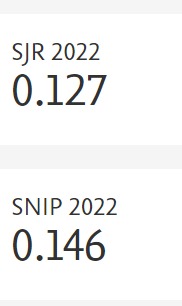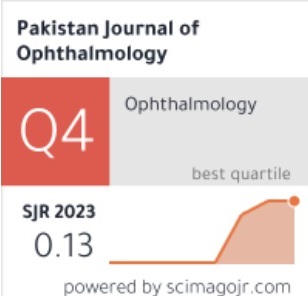External Dacryocystorhinostomy with Intubation in Shrunken Fibrotic Sac in Chronic Dacryocystitis
Doi: 10.36351/pjo.v36i2.1027
DOI:
https://doi.org/10.36351/pjo.v36i2.1027Keywords:
Dacryocystorhinostomy, Canalicular Intubation, Dacryocystitis, Chronic dacryocystitis, Lacrimal Sac, Nasolacrimal duct blockage.Abstract
Purpose: To assess anatomical success rate of external dacryocystorhinostomy (DCR) with intubation in long standing chronic dacryocystitis with shrunken fibrotic sac. Secondary objective was to document frequency of intraoperative and postoperative complications of external DCR in such cases.
Study Design: Quasi experimental study.
Place and Duration of Study: Ophthalmology department, Abbasi Shaheed Hospital, Karachi from January 2015 to December 2017.
Material and Methods: Patients with chronic dacryocystitis for 2 years or more, 18 to 60 years old, repeated acute attacks twice or more in past 1 year and fibrotic sacs were included. Canaliculitis, canalicular blocks, punctal agenesis and enlarged sacs were excluded. Surgeries were carried out under general anaesthesia. Fibrotic lacrimal sac was identified and excised, ostium was created in nasal bone and bi canalicular intubation was done. Surgery was labeled successful if patency of the pathway was achieved by syringing at 6 month postoperatively.
Results: There were 82 patients, with 59 (72%) females. Mean ages were 32 ± 10.3 years. Left eye was seen in 44 (53.7%) patients. Surgery was successful in 61 (74.3%) patients. Intraoperative bleeding occurred 8 (9.8%) and lacrimal crest was difficult to locate in 6 (7.3%) cases. Postoperatively wound infection and ecchymosis was seen in 8 (9.8%) patients, cheese wiring in 5 (6.1%) and fistula was seen in 2 (2.4%) patients. Cross tabulation was done between gender and successful dacryocystorhinostomy which was statistically not significant (p value 0.71).
Conclusion: Dacryocystorhinostomy with intubation has good surgical outcome in long standing chronic dacryocystitis with fibrosed sacs. It has few Intraoperative and postoperative complications but they are manageable.






